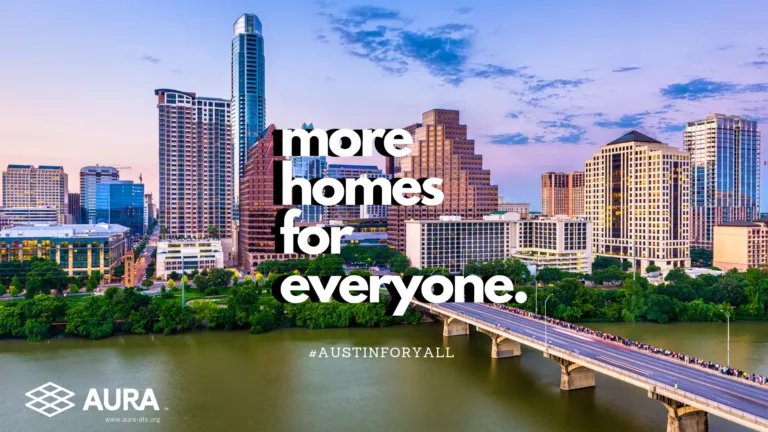As we write a new land development code we are not merely choosing which buildings we’re allowed to build and where we’re allowed to build them. We are making a choice about what kind of city we want Austin to be. Do we want to be a city that looks backward to an imagined golden past, while becoming increasingly more expensive, environmentally destructive, and exclusionary? Or do we want to be a city that looks forward to a better future? One that’s affordable, environmentally sustainable, and full of opportunities for everyone?
In this past year’s election, Austin’s voters firmly resolved on the latter. Therefore, to create an affordable and sustainable Austin with opportunities for everyone, this council must pass a land development code that supports our values by allowing and actively encouraging abundant, transit-oriented housing with walkable access to community needs everywhere in the city and especially in the urban core.
First, for housing costs to go down, we must build enough housing not only to meet current demand but also to meet any future demand. Over the next ten years, 635,000 new people will move to the Austin Metro region, while 128,000 new Austinites will be born here. To make sure all of these people have somewhere to live, we will need to build over 300,000 additional homes. And if we want housing costs to go down, we’ll need to build even more.
Next, unless we want to force all of these people to constantly drive on I-35 or Mopac, we must build the majority of this new housing compactly in the urban core. Today an average metro-resident travels over 180 miles in their car every week, which is why transportation causes 36% of Austin’s 13.5 metric tons of CO2 emissions. To reduce these numbers and prevent paving over the Hill Country and the consequent flooding and water quality concerns, we must create new public transit options. However, for any new mobility plan to work, we must build far more new housing in core neighborhoods and along major transit corridors.
Finally, to build integrated, diverse, complete and accessible communities with opportunities that are open to everyone, we must build a variety of housing, amenities, and businesses for everyone in every neighborhood in Austin. Today Austinites have to travel all over the city to drop off their children at daycare centers and schools, to shop for groceries, and to take care of elderly parents, all on top of driving just to get to work. To lessen these burdens we must build essential services within neighborhoods where people can easily walk to them.
To support these values and achieve these ends, AURA proposes that the three policies set out below must be adopted in our new land development code.
First, we must allow missing middle housing such as six-plexes, row homes, townhomes, and accessory dwelling units by-right everywhere in Austin. As we allow more missing middle housing, we divide the cost of land between more people. That, in turn, lets more people, and especially families, live in Central Austin and enjoy the walkable access to transit, small businesses, jobs, opportunities, and communities that come with that.
Furthermore, development under the current code has restricted the potential for truly affordable units in the urban core and has pushed new market-rate housing into areas the city has traditionally neglected, putting disproportionate pressure on Austin’s poorest residents and communities of color in particular. To combat the displacement resulting from our current code, we need to open up the urban core, and west Austin in particular, to far more market-rate and Affordable housing. Missing middle housing provides the best way to do that.
Second, we must design transition zones that allow for dense, mixed-use, and transit-supportive housing within a ten-minute walk of major corridors. The only way to reduce traffic and CO2 emissions is to get people out of their cars and onto bikes, scooters, buses, and trains or walking – whether that’s for getting to work, taking care of children and elderly parents, or running errands. But people cannot bike, scoot, or walk from Round Rock to downtown Austin. Nor can buses or trains develop the ridership necessary to grow and sustain a public transit system without more people living within walking distance of transit routes.
To achieve this transit-supportive density, we must eliminate minimum parking requirements along corridors to ensure valuable corridor space is not taken up by unnecessary parking. We also either need to relax compatibility standards to allow maximum-density apartment complexes along major corridors or we need to eliminate separate compatibility standards altogether and “zone for compatibility” by mapping high-density, mixed-use zoning on corridors, moderate density within a third of a mile of corridors, and lower missing middle density for residential cores.
Third, we need to relax residential-only restrictions so essential services such as daycares, grocery stores, pharmacies, and doctors can develop within walking distance of where people live. People need convenient access to these services without having to get in a car. Relaxing residential-only zoning restrictions will also give members of different communities the opportunity to start small businesses that help their neighbors live, work, and play in their neighborhood.
Today, Austin is the most segregated city in America by both income and race. It is also one of the most car-dependent and fast becoming one of the most expensive. Our antiquated, woefully inadequate, land development code exacerbates all of these challenges.
We all love Austin despite these problems. To solve them we need a new land development code. We need a code that allows missing middle housing everywhere in Austin. We need a code that creates transit-friendly corridors in every part of Austin. And we need a code that provides complete, walkable communities with essential services in every neighborhood in Austin.
In short, we need a land development code that reflects our values of affordability, environmental sustainability, and opportunity. Only then, can we create an Austin that is truly for Everyone.
AURA Land Use Working Group
Kevin McLaughlin – Chair
Caroline Bailey
Josiah Stevenson
Liza Wimberley
Jordan McGee
Timothy Bray



